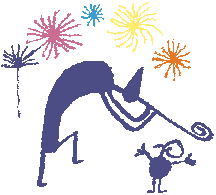Archaeology and Anthropology Links
To General Anthropology and Archaeology Resources Online
To Paleolithic and Neolithic Times
To Texas Arch-Anth //
To Southwestern & Mexican Arch-Anth
Clovis and Folsom Sites
Archaic Sites
To Rock Art Links

To Class Discussion: The First Peoples of the Southwest
Texas Archaeology & Anthropology
Southwestern & Mexican Archaeology
Rock Art Links
To Southwestern U.S. Rock Art //
To Other Rock Art Sites
Texas Rock Art
Lower Pecos Rock Art
Texas Indian Rock Art
Rock Art at Amistad National Recreation Area
Texas Archeology and Rock Art Tours
|
Theories regarding the arrival of the first people to North American range from 15,000-45,000 years ago -
The Paleo-Americans or Paleo-Indians (the Paleo-Indian era 9200-6000 BCE)
While human remains sparse, Paleo-Americans did leave a lot of objects or artifacts American or Columbian elephant, mammoth, mastodon, ancient bison that was 2 to 4 times bigger than modern buffalo, ground sloth; roasted meat in great kitchens or middens in limestone Texas sites include Lubbock Lake Landmark site; Roberts County in Northeast Panhandle (Canadian River area), Gault Site in Central Texas, Denton County, Lewisville, and East Texas Found near Folsom, New Mexico; also in Texas including Hueco Tanks near El Paso where humans have lived for at least 10,000 years, Colorado, Nebraska, and other plains areas A. Development of bow and arrow (in Texas appears to have replaced spear thrower (atlatl) around 700 CE/AD
|
| The Clovis Point and the Discovery of America's First Culture Photos of Clovis Points Clovis Stone Tools Origins of Clovis People American Rock Art Research Association American Rock Art Archive Oldest Rock Art Images of Clovis Rock Art America's Oldest Rock Art Found 12,000-10,000 BCE - Sandia people leave earliest evidence of human existence in New Mexico; "Tepexpan Man" in Mexico and "Midland Minnie" in Texas Before 11,000-8000 BCE - First immigrants arrive in Texas 11,000-7,000 BCE (estimates vary) - Early hunters period; nomadic foragers, fishing, some seed collection 11,000-10,000 BCE - Diablo Phase, unspecialized foraging tools, Northern Mexico (Tamaulipas) 10,000-9,000 BCE - Clovis hunters roam area in search of mammoth, bison and other game 10,000-500 BCE - Cochise people cultivate corn, squash, beans; earliest evidence of agriculture north of Mexico in Southwest 9,000-8,000 BCE - Folsom people flouish throughout Southwest at end of last Ice Age 8000-7000 BCE - Burials in Texas; "Midland Minnie" in Williamson County 7400-6700 BCE - Oaxaca Valley of Mexico - bottle gourds, pumpkin 7000 BCE - Tehuacan Ajuereado Phase of Central Highlands of Mexico; bands of 12-15 people; some big-game hunting 6500-2000 BCE - Archaic (Incipient Farming) Period; gradual development of horticultural skills, some signs of fixed settlement, possibly some shamanism; extinction of many animals; Desert Cultures develop in U.S. West and northern Mexico 4000 BCE - People in lower-Pecos River area leave distinctive Rock Art 1500 BCE - Corn farmers settle near Presidio (La Junta de los Rios - "meeting of the rivers" - where Mexico's Rio Conchos and Rio Grande join 1500-900 BCE - Early Formative (Pre-Classic) Period; "Neolithic" farming villages; pottery, looms, ground stone figurines, rule by groups of elders, shamans, chiefs; rain & fertility cults; regional differentiation 1350-1100 BCE - El Arbolillo, Tlatilco, and Zacatenco figurine cults of the Central Highlands Tlatilco - large, rich village; storage pits, animal and human sculpture; 340+ burials 900-300 BCE - Middle Formative (Pre-Classic) Period - Olmec civilization; widespread trade; diffusion of Olmec traits; class divisions La Venta (Tabasco) - greatest Olmec site, Tres Zapotes (Veracruz) contemporaneous with La Venta 300-1 BCE - Teotihuacan Phase I; Central Highlands 300 BCE - 250 CE - Late Formative (Pre-Classic) Period; "urban revolution" - building of great urban centers in Mesoamerica 1-300 CE - Teotihuacan Phase II - Pyramid of the Sun constructed 1-700 CE - Anasazi Basketmakers elevate weaving to a high art, creating baskets, clothing, sandals, and utensils 150 CE - Volcano destroys Cuicuilco, leaving Teotihuacan unrivaled in the Central Highlands 150-650 CE - Early Classic Period; Teotihuacan Phase III with much influence elsewhere 500-900 CE - Classic period for Monte Alban with major temples built, population estimated at 24,000, 170 underground tombs with frescoes 250-600 CE - Dawn of classic Maya culture 300-1400 CE - Mogollon culture introduces highly artistic pottery and early architecturee in the form of pit houses 1200-1500s CE - Pueblo Indians establish villages along the Rio Grande and its tributaries 800-1500 CE - Farmers/hunters build and occupy the "Buried City" southeast of Perryton in Ochitree County on the northern edge of the Panhandle as well as other sites along Canadian River 1400 CE - The Caddo Confederacy establishes a civilization in East Texas based on agriculture |
To Next Class Discussion: The Caddo Confederacy of East Texas